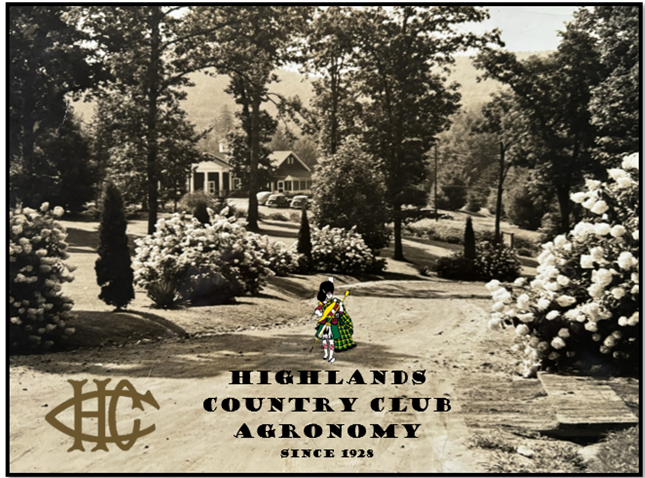I've been asked recently to describe the types of grasses we have on the playing surfaces at Highlands CC. It's a great question and thought you might find interest in the answer.
1. Putting Greens:
Highlands CC putting greens were rebuilt in 1998. Prior to that, the greens were 100% Poa annua that grew on a 'push up' style green. This means, they were built by pushing up soil in a given area and grass was planted on the rich topsoil. While it sounds great, the rootzone was excellent in terms of nutrients but very poor in terms of drainage. After rain events, the soil held so much water, that the golf course was often unplayable. In 1998, the Club rebuilt greens to a USGA sand based spec. This improved the drainage situation which allowed golf to be played during and after rain events. The greens were seeded with creeping bentgrass, specifically a variety known as Penn A4, developed at Penn State University by longtime plant breeder, Dr. Joe Duich. Interestingly, Penn A4 originated from the Par 3 course at Augusta National, where Dr. Duich had a longtime relationship with the Superintendent, a Penn State graduate himself. Penn A4 was part of the A and G series of Bentgrasses, names after Augusta, Georgia. Penn A4 is still a popular grass species today. Overtime, like all greens in our area, bentgrass putting greens become inundated with Poa annua, a native plant in Highlands. Our climate is very conducive to Poa annua growth that is extremely difficult to eradicate. Fortunately for us, this is one of a select few areas in the US that Poa annua can be managed to be a great putting surface. Combined with the amount of shade and poor air circulation we have on our greens, bentgrass simply cannot compete with Poa annua. Our greens are mowed at 0.115".
2. Tees:
Highlands CC tees are sand based systems and were sodded with Penn Trio, a 3-way blend of several bentgrasses developed at Penn State University. Like the greens, there is a fair amount of Poa annua in the tees. Our tees are mowed at 0.350".
3. Fairways and Approaches:
Highlands CC fairways are primarily comprised of creeping bentgrass. While we've inner-seeded fairways with a number of newer varieties of bentgrasses, most of this bentgrass existed from day one at Highlands CC. Many of these bentgrasses are so old, it would be impossible to determine what they are. Turf breeding is done to propagate grasses that are denser, upright in growth habit and finer leave textures. After all, the more grass blades per square inch, the better a golf ball is supported below. Unfortunately, a lot of the old bentgrasses on our fairways are leggy and not very conducive to supporting a golf ball. Speaking of density...wonder which turfgrass is the densest and most upright??? If you guessed Poa annua, you would be correct! Unfortunately, too many golfers think of Poa annua as a weed. I often say that if I gave every member a golf ball and told you to place the ball on the turf in the most desirable lie you could want.... I would bet that 95% or more of the golf balls would be placed on a patch of Poa annua without the member even realizing it. Our fairways are mowed at 0.450", just under 1/2" and approaches are mowed at 0.300".
4. Rough:
Finally, there is the rough. In Highlands, rough usually turns into a Heinz 57 variety because everything grows so well. Ideally, we sod roughs to Kentucky Bluegrass or sometimes Tall Fescue. However, due to spring weather conditions, the Kentucky Blue loses its competitive advantage. This is where the bentgrasses invade the turf. The problem is, creeping bentgrasses grow at temperatures much lower compared to Kentucky Bluegrass (KBG). KBG doesn't resume active growth until temperatures hit 80 degrees F. This means for the months of March, April, May, October and November, bentgrass invades KBG with zero competition. In warmer, dryer climates, Superintendents have the ability to kill off the bentgrasses by withholding water from the roughs. Here, we have no such luxury. In addition to our KBG/bentgrass mixed rough, one can also find clumps of Ryegrass and even Poa annua. There are some chemistries available now to help with this but they are far from being 100% effective. Our roughs are mowed at 2". Our intermediate rough cut is set at 1.25".

